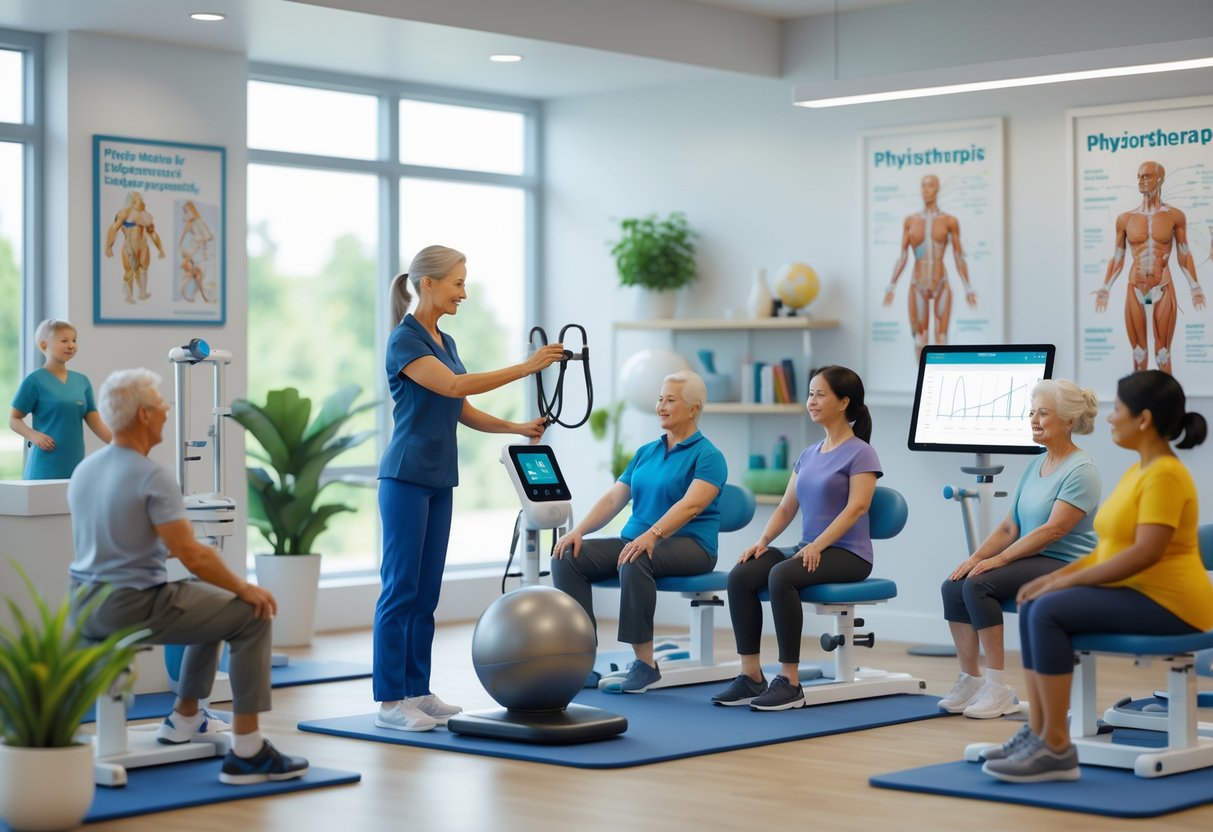Physiotherapist Need: Essential Skills, Qualities, and Pathways
Updated On: August 23, 2025 by Aaron Connolly
What Physiotherapist Need to Succeed
Succeeding in physiotherapy means blending clinical know-how with real, human qualities. You can’t just rely on textbook knowledge; you have to connect with people and keep the patient at the center of everything.
Core Competencies Required
Clinical reasoning really sets apart skilled physiotherapists from those just starting out. We have to assess patients thoroughly and come up with treatment plans that actually make sense for each person.
Exercise prescription is another huge part of the job. We look at what each patient can handle, what they want to achieve, and what might hold them back. Only then can we create rehab programs that actually work and keep people from getting hurt again.
We need to stay sharp with research literacy. The field keeps changing, so we have to keep up with new studies to make sure we’re offering the best care.
Technology is everywhere now. We use telehealth, digital rehab tools, electronic health records, and even movement analysis software—sometimes it feels like there’s always something new to learn.
Working with other professionals is just part of the deal. We team up with doctors, nurses, occupational therapists, and plenty of others to make sure patients get well-rounded care.
Learning never really stops in this field. If you want to stay relevant, you have to keep picking up new skills and adapting to new treatments.
Key Personal Qualities
Empathy and compassion aren’t just nice to have—they’re essential. Patients get nervous or scared, and we have to show them we genuinely care about their health.
Listening, really listening, makes a big difference. When we understand what patients are worried about and what they hope to achieve, we can actually help them better.
Cultural competence is important, too. Every patient brings their own background and beliefs, and we need to respect that.
Patience is something you learn quickly. Recovery doesn’t happen overnight, and some patients struggle or move slowly. We have to be there for them, even on tough days.
Physical stamina and emotional resilience are must-haves. The work is demanding—sometimes physically, sometimes emotionally, and often both.
Communication skills help us explain complicated stuff in ways people actually understand. If we can’t do that, patients won’t follow through.
Importance of Patient-Centred Care
Patient education matters more than people think. We need to teach patients about their conditions and how to help themselves, not just do things for them.
Individualised treatment plans are key. Every patient is different, so we can’t just follow generic routines and expect good results.
We make sure patients get involved in decisions about their care. When they understand their options and help plan their treatment, they’re much more likely to stick with it.
Taking care of ourselves is part of the job, too. If we’re burnt out, we can’t really help anyone else.
Checking in on our own skills and reflecting on what we could do better keeps us growing as professionals.
Building trust and good relationships with patients goes a long way. When patients feel safe and understood, they’re more likely to open up and work hard at recovery.
Essential Clinical Skills
Physiotherapists rely on a handful of core clinical abilities to help patients get better. These hands-on skills really form the backbone of what we do.
Movement and Exercise Prescription
Exercise prescription is at the heart of physiotherapy. We create movement routines that actually fit each patient’s goals and physical limitations.
Assessment-Based Programming
Before we hand out exercises, we dig in with movement assessments. We look at gait, posture, joint mobility, and muscle strength.
These assessments help us spot bad movement patterns that could lead to more injuries if we ignore them.
Progressive Exercise Design
We always start with exercises that match where the patient is right now. If we ask too much, they might get hurt again. If we go too easy, nothing changes.
To make progress, we tweak things like:
- Load intensity (how much weight or resistance)
- Volume (reps and sets)
- Complexity (simple moves to more challenging ones)
- Environment (stable floor to wobbly surfaces)
Home Programme Integration
We put together home exercise routines that are actually doable. Easy instructions and demo videos help patients stick with it.
Manual Therapy Techniques
Manual therapy is all about using our hands to help with pain and movement. It takes a lot of practice to get right.
Joint Mobilisation Skills
We use different grades of mobilisation depending on the goal. Lighter techniques help with pain, while stronger ones restore movement.
Hand placement can make or break the technique. We have to be precise.
Soft Tissue Techniques
We use massage, stretching, and other hands-on methods like trigger point release and myofascial release. Each technique tackles a different problem.
We always watch how patients respond and adjust pressure as needed. If something feels off, we talk it through right away.
Clinical Reasoning Application
We pick our techniques based on what we find during assessments. Acute injuries usually need gentle care, while chronic issues might need more aggressive work.
We always check for contraindications—some techniques just aren’t safe for certain conditions.
Aquatic Therapy Methods
Water-based rehab brings something special to the table. Buoyancy, resistance, and water pressure help people recover in ways land-based therapy can’t always match.
Buoyancy Applications
Water supports the body, so patients can move sooner after surgery without overloading joints. We adjust water depth to control how much weight they bear.
Deeper water gives more support. For example, chest-deep water cuts weight-bearing down to about 25% of body weight.
Resistance Training
Water resists movement in every direction. We can make exercises harder by speeding up movements or adding equipment.
The turbulence in water also challenges balance and body awareness.
Temperature and Pressure Benefits
Warm water helps muscles relax and gets blood flowing. Hydrostatic pressure can reduce swelling and even dull pain a bit.
We always keep an eye on water temperature. Too hot or too cold, and it messes with the benefits.
Educational and Qualification Requirements
To become a physiotherapist, you need to earn a Doctor of Physical Therapy degree and pass licensing exams. Let’s break down what the path actually looks like.
Necessary Academic Qualifications
Bachelor’s Degree Foundation
Most programs want you to have a bachelor’s degree first. You’ll need to be solid in biology, chemistry, physics, and math.
Some schools offer 3+3 programs, so you can jump into the professional track after three years of pre-professional classes.
Doctor of Physical Therapy (DPT) Programme
The DPT is the go-to qualification now. These programs usually take three years if you go full-time.
You’ll study things like:
- Anatomy and physiology
- Biomechanics and kinesiology
- Exercise physiology
- Pathology and pharmacology
- Clinical reasoning and ethics
- Cardiovascular and pulmonary systems
- Musculoskeletal assessment
Clinical Experience Requirements
Most of your DPT work happens in the classroom or lab—about 77%. The rest is hands-on clinical education.
Expect around 22 weeks of clinical placements in places like hospitals, clinics, and sports centers.
Required Certifications and Licences
State Licensing Examination
After you graduate, you have to pass the National Physical Therapy Examination (NPTE). It’s computer-based and checks your clinical knowledge.
Each state sets its own passing score and rules about how many tries you get.
State-Specific Requirements
Some states want extra things like:
- Jurisprudence exams (covering state laws)
- Background checks
- Continuing education credits
- Proof of liability insurance
Specialisation Certifications (Optional)
Once you’re licensed, you can get board-certified in areas like:
| Specialty Area | Focus |
|---|---|
| Orthopaedics | Musculoskeletal conditions |
| Neurology | Brain and spinal cord injuries |
| Pediatrics | Children’s development |
| Sports | Athletic injuries |
| Geriatrics | Age-related conditions |
You’ll need extra clinical experience and exams for these.
Professional Registration Procedures
Initial License Application
You submit your application to your state’s board with:
- DPT transcripts
- NPTE scores
- Background check results
- Application fees (usually £200-400)
Maintaining Your Licence
Most states want you to renew every 1-3 years. You have to complete continuing education to keep your registration active.
This usually means:
- 20-30 CEU hours per renewal
- Ethics or law training
- Renewal fees
- Proof of liability insurance
Multi-State Practice Options
The Physical Therapy Licensure Compact lets you work in other participating states without extra hassle.
Right now, over 30 states are in the compact. You need a license in one of those states to qualify.
Rehabilitation Expertise
Physiotherapists have to know how to make personal treatment plans, guide patients through recovery, and track their progress. These skills make sure each person gets care that actually fits their injury or condition.
Developing Individualised Rehabilitation Plans
Every patient needs something different to get back on track. We start by figuring out what’s wrong, what hurts, and what the person wants to achieve.
A solid plan sets clear, measurable goals. Maybe a football player wants to run without pain. Maybe someone at a desk just wants to lift boxes again.
Key parts of a personal plan include:
- Goals you can actually measure
- Exercises that fit the person
- A timeline for progress
- Adjustments as things change
We always consider what the person does at work and what they like to do for fun. Desk workers and heavy lifters need different plans. The plan has to work in real life, not just on paper.
Supporting Patient Recovery Processes
Recovery isn’t quick, and it’s rarely easy. Patients worry, get frustrated, or even doubt themselves. We try to help them understand what’s happening and why certain exercises matter.
Our role in supporting recovery:
- Teaching good exercise form
- Explaining how and why treatments help
- Helping with pain management
- Cheering them on, especially when things are slow
We watch for signs that someone might quit or push too hard. Both can hold back progress. Some days, patients feel great and want to do too much. Other days, they feel worse and get discouraged.
Building trust is everything. When patients believe in their treatment, they’re more likely to stick with it. We remind them that setbacks are normal and part of getting better.
Measuring Progress and Outcomes
We track improvement to see if things are working. There are lots of ways to measure progress, like checking how far someone can move or how long they can walk without pain.
Common ways we measure progress:
- Range of motion tests
- Strength checks
- Pain scales
- Functional ability ratings
Regular check-ins help us catch problems early. If things aren’t going as planned, we make changes. Maybe new exercises, maybe more rest.
We also ask patients how they feel about their progress. Numbers only tell part of the story. Someone might move better but still feel nervous about daily activities. That feedback helps us tweak the plan.
Good records help us see trends over time and let other healthcare workers know what’s been tried and what’s working best for each person.
Effective Communication and Interpersonal Skills

Strong communication really sits at the heart of good physiotherapy. We need to connect emotionally with patients, team up with their families, and build trust if we want to help people reach their goals.
Empathy and Compassion
Empathy helps us get what patients go through as they recover. When we actually listen to their concerns and frustrations, they feel seen and respected.
Compassion goes a step further. It pushes us to act in ways that truly support patients.
We show empathy by:
- Actively listening and not jumping in
- Recognizing pain and emotional struggles
- Saying things like, “I get that this is tough for you”
Body language matters, too. Sitting at eye level and making eye contact shows we’re there with them.
Compassionate replies help patients handle setbacks. Instead of pointing out mistakes, we might say, “A lot of people find this tricky at first.”
Patients who feel understood are more likely to stick with their treatment. They usually report better pain relief and feel more satisfied with their care.
Collaborating with Patients and Families
Physiotherapy works best when we treat patients and families as partners. We involve them in decisions and respect what they know about their own bodies.
We start by asking about their goals. What do they want to get back to doing? What worries them most right now?
Family members often help out at home. We need to show them the right way to assist with exercises or transfers. A quick demo usually works better than a long explanation.
Some tools make teamwork easier:
- Exercise charts with pictures
- Progress sheets
- Simple diagrams
- Short videos for home practice
We check in regularly to tweak the plan. Questions like, “How did those exercises go this week?” or “What’s working at home?” help us adjust.
When patients push back on our advice, we dig a bit deeper. Sometimes, it’s fear or a bad experience from the past holding them back.
Building Trust and Rapport
Trust grows when patients know we’re on their side. That starts from day one, with honest, steady communication.
We build rapport by showing real interest in patients as people. Remembering their work, hobbies, or family makes a difference.
Being upfront about recovery timelines helps avoid disappointment. If rehab usually takes 6-8 weeks, we say so, instead of promising a miracle.
We keep relationships professional but still warm and caring.
Trust builds when we:
- Show up on time
- Do what we say we’ll do
- Admit if we don’t know something
- Refer to other experts when it’s needed
Patients notice when we’re really present, not just rushing through. Even a few extra minutes of focus can make a big difference.
Clear explanations about treatments help patients understand why they’re doing each exercise. When they get the reason, they’re more motivated to keep going at home.
Clinical Reasoning and Decision Making

Physiotherapists use clinical reasoning every session. We size up patients, plan treatments, and solve tricky problems by mixing quick pattern recognition with careful analysis.
Assessment and Diagnosis Techniques
We lean on two thinking systems during assessment. System 1 is automatic—if we’ve seen it before, we spot it fast. For example, a familiar limp or posture stands out right away.
System 2 kicks in when things get weird or new. We slow down, gather details, and test ideas through physical tests and patient history.
Assessment starts with just watching. We notice how patients move, sit, or describe pain. Experienced physios can spot common issues like tennis elbow fast.
If things aren’t clear, we switch to analysis. We test out different ideas with range of motion checks, strength tests, or other exams.
Good assessment blends both systems. We get a quick first impression, then dig deeper to confirm or rule things out. This combo cuts down on mistakes.
Evidence-Based Treatment Planning
We balance research, our own experience, and what the patient wants. Those three factors shape every plan.
Research points us toward what usually works. For example, studies show exercise helps most musculoskeletal problems more than just resting. We use this but always tweak for each person.
Patient goals matter a lot. A pro athlete and an older adult need totally different plans, even for similar injuries.
We use clinical reasoning to adapt evidence-based treatments. Sometimes a standard protocol needs changes for medical reasons or patient feedback. We keep reassessing and shifting the plan.
We also try to predict outcomes. Our experience and the research help us set honest goals and timelines, so patients know what to expect.
Problem-Solving in Complex Cases
Tough cases really test our thinking. Sometimes patients have more than one diagnosis, or don’t get better with usual treatments.
We break down complex problems into smaller pieces. With chronic pain, for example, we might look at physical, psychological, and social factors.
If a treatment isn’t working, we rethink our approach. Maybe we missed something, or another issue is blocking progress. We gather more info or try something else.
We get better results when we collaborate. Talking with colleagues or other health pros often brings new ideas.
Documenting our process keeps things clear. We write down our thoughts, test results, and what we tried. This helps track what works and what doesn’t.
Reflecting on tough cases helps us grow. We look at what went well and what didn’t, so we’re better prepared next time.
Patient Education and Empowerment

Physiotherapists give patients the tools to manage their own health. Teaching and sharing knowledge is key to long-term recovery.
Promoting Self-Management
We show patients practical skills for home. That means teaching exercises, explaining when to use heat or ice, and helping them spot warning signs.
We teach self-management skills like:
- Home exercise routines with good form
- Pain control techniques
- How to pace activities
- Using equipment safely
Patients track their own progress and adjust as needed. We hand out guides and video demos so they can check back later.
This approach builds confidence. Patients who understand their plan become active partners, not just passive recipients.
We check in regularly to update the plan. We celebrate wins and tackle any problems together.
Educating on Prevention Strategies
We help patients avoid future injuries by teaching prevention. Each plan is tailored to their specific risks.
Some prevention topics we cover:
| Area | Examples |
|---|---|
| Workplace ergonomics | Desk setup, safe lifting |
| Exercise habits | Warming up, slow progress |
| Daily activities | Moving safely, posture checks |
| Sports-specific | Better technique, using the right gear |
We teach patients to notice early warning signs like muscle tension or joint stiffness.
Heads up: Many people drop prevention once they feel better. We remind them that prevention needs to stick around.
Lifestyle tweaks often mean less need for physio later. Simple stuff like stretching, good shoes, or a better workspace can help a lot.
We hand out tools like exercise calendars and posture reminders that fit into daily life.
Adaptability and Lifelong Learning

Physiotherapy changes fast with new research and tech. We need to keep up, keep learning, and stay flexible.
Staying Updated with Latest Research
Research shapes how we treat patients. Every year brings something new.
We try to read journals like Physical Therapy, Physiotherapy, and Journal of Orthopaedic & Sports Physical Therapy as often as possible.
Evidence-based practice needs sharp thinking. Not every study fits every patient, so we have to judge what’s useful.
Many of us join professional groups for research access. For example, the Chartered Society of Physiotherapy gives members journal subscriptions and summaries.
Quick tip: Set aside 30 minutes a week for one research article. It’s doable and keeps you learning.
Guidelines change as evidence shifts. Treatments for things like back pain have evolved a lot lately. We need to keep our practice up to date.
Embracing Technological Advances
Tech is changing how we work. Digital tools let us care for patients in new ways.
Telehealth has become a big part of what we do. We need to know how to use video calls and online tools for remote care.
Wearables and smartphones track movement and progress. They give us data for better treatment plans.
Virtual reality is even helping with balance and pain. Some clinics use motion capture for gait analysis. Learning these tools keeps us current.
We handle electronic records, too. That means knowing how to document care and protect patient data.
Apps help patients stick with exercises at home. We should know which ones work well and how to use them.
Continuous Professional Development
Ongoing learning keeps us registered and sharp. Most places require it for license renewal.
Formal courses include workshops, seminars, and certifications. Specialties like sports or paediatrics need extra training.
Mentorship and chatting with peers teach us things books can’t. More experienced colleagues can offer tips that really help.
Clinical supervision helps new grads grow. Senior physios guide decisions and treatment choices.
Self-reflection shows us where we need to improve. Feedback from patients can highlight blind spots.
Professional networks offer more learning chances. Local groups run events and case discussions.
Online learning works for busy schedules. Webinars and recorded lectures fit in when you have time.
Cultural Competence in Physiotherapy

Cultural competence lets us care for people from all backgrounds. We respect different beliefs and values so everyone gets the treatment that fits them best.
Respecting Diversity in Patient Care
Learning about our patients’ cultures really changes outcomes. People have unique ideas about health, pain, and healing that shape how they respond.
Language barriers can be tough. If we can’t speak their language, giving instructions gets tricky and results can suffer.
Cultural beliefs about health aren’t the same everywhere. Some patients want to use traditional remedies along with physio. Others may feel differently about touch or exercise.
Family roles change by culture, too. In some places, families want to join in decisions. We respect that, but still protect privacy.
Assessment needs cultural awareness, too. How people express pain or describe symptoms can vary. We have to keep that in mind.
Some things that help:
- Learning about a patient’s background
- Asking about their beliefs and preferences
- Using professional interpreters when language is a barrier
- Including family when it makes sense
- Tweaking treatment plans to fit cultural values
Ensuring Inclusive Practice
Building truly inclusive physiotherapy services takes more than good intentions—it’s about making real, ongoing changes in how we work. We need to adapt our environments and approaches so we can actually serve everyone who comes through our doors.
Training and education really set the stage for cultural competence. We can’t just do a one-off course and call it a day. Regular training helps us understand different cultural attitudes toward health and the many ways people communicate.
Practice modifications also matter:
- Ask for cultural and language info on registration forms.
- Hire bilingual staff or bring in interpreters.
- Offer educational materials that actually make sense for different cultures.
- Stay flexible with appointments, especially around religious holidays.
Self-reflection keeps us honest about our own biases. We’ve all got them, whether we like it or not. Taking time for real self-examination helps us spot assumptions that might creep into patient care.
Patient feedback is a goldmine. When we ask patients about their experiences, they’ll often point out things we didn’t even realize needed improvement. Their input shows us where our cultural competence could use some work.
Matching practitioners and patients by background can help sometimes, but it’s not a substitute for everyone building their own cultural competence. We can’t just rely on perfect matches.
We keep learning about cultural competence throughout our careers. We’re bound to mess up now and then, but if we address those mistakes openly, we’ll get better at serving everyone.
Collaborative Practice and Teamwork

Modern physiotherapy thrives on teamwork. We have to work closely with other healthcare professionals, and honestly, clear communication makes all the difference.
These skills don’t just make our lives easier—they actually improve patient outcomes and help us create more effective treatment plans.
Interprofessional Communication
Good communication sits at the heart of physiotherapy. We share patient information, treatment plans, and updates with doctors, nurses, occupational therapists, and others.
Daily communication tasks:
- Write up detailed patient notes.
- Join in on team meetings.
- Talk through treatment goals with patients and their families.
- Coordinate schedules with other professionals.
When we communicate well, we avoid conflicting treatments and ensure everyone’s on the same page. If we’re helping a stroke patient regain mobility, we’re definitely talking to speech and occupational therapists.
Key skills for us:
- Actually listening to others during team discussions.
- Explaining things clearly, without jargon, for patients.
- Writing notes that make sense to everyone else.
- Handling disagreements when our approaches clash.
Working with Other Healthcare Professionals
Physiotherapy almost never happens in a vacuum. We’re always working alongside others who bring their own expertise.
Common team members:
- Doctors: They diagnose and prescribe.
- Nurses: They keep tabs on patient health and handle treatments.
- Occupational therapists: They focus on daily living skills.
- Social workers: They help with support and housing needs.
Every profession comes at things differently. If we understand where others are coming from, it’s a lot easier to work together. Disagreements will happen—maybe about timing or methods—but in the end, we all want what’s best for the patient.
Collaboration works best when we:
- Respect what others know.
- Share what we observe with patients.
- Stay flexible with our schedules.
- Jump in during team decisions.
Working as a team can cut down on duplicate treatments and lower costs. Most importantly, it means patients get care that covers all the bases.
Self-Care and Professional Wellbeing

Physiotherapists face some unique pressures that can wear us down, both physically and mentally. Studies say about 34% of physical therapists feel burnout affects their patient care, so looking after ourselves isn’t just nice—it’s necessary.
Managing Stress and Preventing Burnout
Burnout isn’t just about feeling tired or fed up. It can make us less effective and even put patient safety at risk.
Signs of burnout:
- Feeling wiped out or dreading work.
- Struggling to focus during sessions.
- Feeling disconnected from patients.
- Dealing with headaches or sleep issues.
Physiotherapy can be physically demanding, and the emotional side of the job adds up too. We spend a lot of time one-on-one, sometimes with tough cases.
Some stress management ideas:
- Try mindfulness apps for quick meditations or breathing between appointments.
- Lean on colleagues for support and venting.
- Set boundaries around work hours and patient messages.
- Check in with yourself each week about how you’re coping.
If you need professional help, go for it. Lots of physiotherapists benefit from counseling, workshops, or talking with their GP about extra support.
Balancing Work and Personal Life
Drawing a line between work and home life matters if we want to stay healthy and keep doing our jobs well.
Work-life balance tips:
- Take actual breaks during busy days.
- Don’t check work emails after hours.
- Make time for hobbies you enjoy.
- Keep friendships outside of healthcare.
We have to walk the talk when it comes to physical self-care. If we don’t look after ourselves, it’s hard to help our patients do the same.
Self-care basics:
- Do exercise you actually like.
- Aim for 7–9 hours of sleep.
- Eat well, even on hectic days.
- Take your holiday leave, and don’t feel guilty about it.
If your workplace isn’t supporting your wellbeing, speak up. Maybe you need to talk about your caseload, ask for more flexible hours, or look for a setting that fits your life better.
Frequently Asked Questions

People often wonder what it really takes to become a physiotherapist. The journey involves specific qualifications, certain degrees, and steps that can look different depending on where you live.
What qualifications are required to become a physiotherapist?
To practice as a physiotherapist, we need a recognised physiotherapy degree from an accredited university. The coursework covers anatomy, physiology, biomechanics, and hands-on clinical practice.
Most countries also ask us to register with a professional body after we graduate. In the UK, that’s the Health and Care Professions Council (HCPC).
During our studies, we go on clinical placements in hospitals, clinics, and community settings. We get real-world experience under supervision.
How long is the educational journey to become a physiotherapist?
A bachelor’s degree in physiotherapy usually takes three to four years. We split our time between classroom learning and clinical placements.
Some people go for a master’s degree instead. These programs last about two years and require a previous degree in a related field.
After graduating, we often take extra training or specialise. Depending on the focus, this might add months or even years.
Is a doctoral degree necessary to practice as a physiotherapist?
In the UK and a lot of other places, we can practice with just a bachelor’s or master’s degree. A doctorate isn’t required for basic practice.
In the United States, though, you need a Doctor of Physical Therapy (DPT) degree now. That’s the new standard there.
Doctoral programs go deeper into clinical skills and research. They usually take three years and include a lot of clinical work.
Can one practice as a physiotherapist with just a bachelor’s degree?
Yes, in most countries, a bachelor’s degree from an accredited university is enough to start practicing as a physiotherapist.
Bachelor’s programs teach us everything we need for entry-level work. We learn assessment, treatment, and professional standards.
We still have to register with the right professional body after we graduate. That’s how we show we meet national safety standards.
What are the steps involved in training to be a physiotherapist?
First, we take prerequisite science courses like biology, chemistry, and physics. That gives us the basics for physiotherapy studies.
Then we apply to and finish an accredited physiotherapy degree program. This includes both theory and supervised clinical placements.
After graduation, we register with the appropriate professional body in our country. Once we’re registered, we can start practicing and keep up with continuing education.
A lot of physiotherapists also do extra training in areas like sports medicine or neurology. That helps us work with specific groups of patients.
How does the salary of a physiotherapist typically reflect their level of education and experience?
Entry-level physiotherapists with just a bachelor’s degree usually start out earning less than folks with more advanced qualifications.
As physiotherapists gain more education, pick up specialisations, and rack up years of experience, their salaries go up.
In the UK, if you’re newly qualified and working in the NHS, you’ll probably start somewhere between £24,000 and £30,000 a year.
Once you build up experience and add extra qualifications, you might see your salary climb to £40,000, £80,000, or even higher.
Physiotherapists in private practice often take home more than their counterparts in public healthcare.
Their earnings really depend on where they work, what they specialise in, and, honestly, how good they are at running a business.
If you go for advanced degrees or pick up niche specialisations, you’ll usually have a better shot at higher pay.
Physiotherapists with doctoral degrees or specialist certifications often charge premium rates for what they do.

